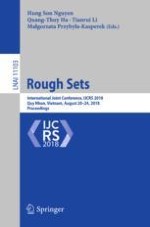2018 | OriginalPaper | Buchkapitel
Rule Induction Based on Indiscernible Classes from Rough Sets in Information Tables with Continuous Values
verfasst von : Michinori Nakata, Hiroshi Sakai, Keitarou Hara
Erschienen in: Rough Sets
Aktivieren Sie unsere intelligente Suche, um passende Fachinhalte oder Patente zu finden.
Wählen Sie Textabschnitte aus um mit Künstlicher Intelligenz passenden Patente zu finden. powered by
Markieren Sie Textabschnitte, um KI-gestützt weitere passende Inhalte zu finden. powered by
